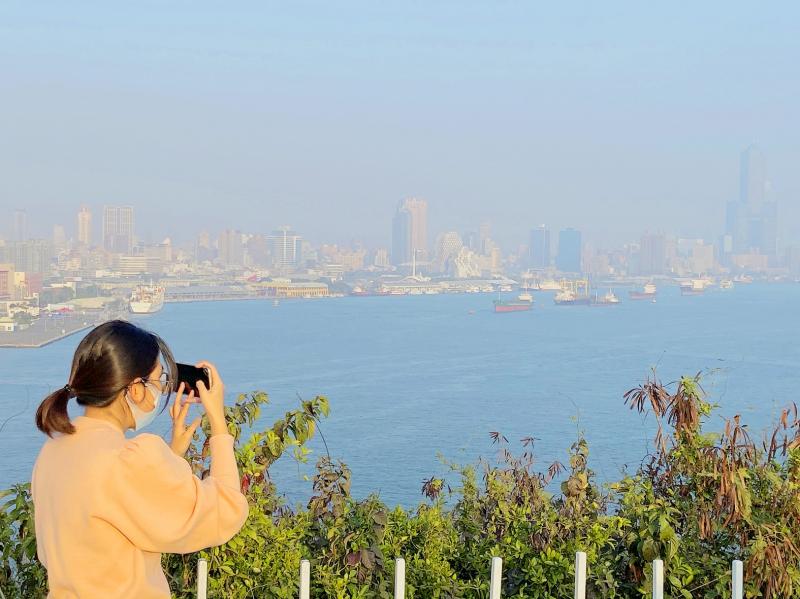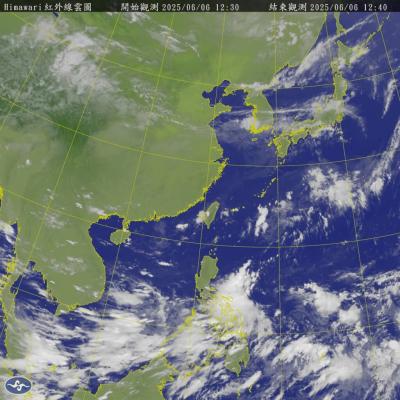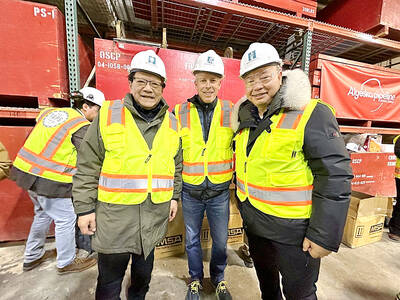An air quality monitoring station at National Central University (NCU) has become an index station for NASA’s regional measurements due to the accuracy of its data, the university said yesterday.
The station uses micropulse lidar to determine the source of air pollutants, by measuring changes in wave forms when they are bounced back by atmospheric particulate matter, the university said.
Chang Shuenn-chin (張順欽), director-general of the Environmental Protection Administration’s (EPA) Department of Environmental Monitoring and Information Management, said the station has overcome the challenge of determining pollutant sources, which had plagued EPA officials before.

Photo: CNA
“Although ground-level sensors can tell you about the special characteristics of pollutants in a particular area, they cannot tell you the direction particles fall in or how they disperse,” he said.
The EPA started using micropulse lidar technology from NASA in 2002, when it began long-term monitoring of particle dispersal.
The data it collected allowed it to analyze air pollution patterns and concentrations, and to gain a more accurate understanding of air quality changes, Chang said.
The micropulse lidar system can gather readings from as high as 30km in the atmosphere, at a vertical resolution of 75m, and gathers information 24 hours a day, he said.
“If the wave forms of backscattered electrons it detects are irregular, it has likely detected elements from the Earth’s crust, for example from a sandstorm,” he said.
“Globular wave forms likely indicate pollutants produced by high-temperature combustion,” he said.
NASA has collected atmospheric data in this manner since 2000 through the US federated Micro-Pulse Lidar Network (MPLNET), university assistant professor Wang Sheng-hsiang (王聖翔) said.
The network collects data from around the world, and is able to analyze the environmental effect of smog and sandstorms in China, as well as from the slash-and-burn agricultural practices employed in Indochina, he said.
MPLNET comprises 26 monitoring stations worldwide, four of which are in Taiwan. Taiwan’s stations are at the National Central University in Taoyuan, as well as in Taichung’s Situn District (西屯), Yunlin County’s Douliou City (斗六) and Kaohsiung’s Zuoying District (左營).
The university’s station was added to MPLNET due to the maintenance of its equipment and the reliability of its data, Wang said.
“The university’s system is in a temperature and humidity-controlled environment, and the lens is cleaned even more frequently than those at US monitoring stations,” he said.
Cooperation with NASA on MPLNET is important given the global interest in tackling air pollution and improving air quality, Chang said.
Air quality can be affected by natural or synthetic phenomena, he said.
Examples of the former include sandstorms, volcanic activity, sea spray, forest fires and the erosion of geological formations, while sources of synthetic pollutants include factories, motor vehicles, construction and farming, Chang said.
Air pollutants include particles with a diameter of up to 10 micrometers and those with a diameter of up to 2 micrometers, ozone, vulcanized materials, nitrogen oxide, carbon monoxide and lead.
The EPA measures air pollution nationwide at 111 monitoring stations, which include 77 standard monitoring stations, 10 mobile stations and other facilities that take measurements using light and other methods.
The stations have measured decreases in most pollutants in the past few years, but have shown annual increases in the concentration of ground-level ozone, which can cause breathing difficulties and chest pain, the EPA said.
Air quality in Taiwan is affected by seasonal winds and geography, Chang said.
“Strong northeasterly winds blow between October and April, bringing pollutants from China,” he said, adding that the central mountain chain then weakens the wind, so that pollutants become trapped above central and southern Taiwan.
However, southwesterly winds that blow between May and September bring stronger winds to central and southern Taiwan, so air quality in those regions improves, he said.
Meanwhile, air quality is worse during the day due to human activity, with pollutants reaching peak concentrations at about 6am and 6pm due to heavy traffic, he said.
Also, concentrations of nitrogen oxide and carbon monoxide are on average 1.2 times higher during work days than on weekends, he said, adding that concentrations are 1.7 times higher during rush hour.
Meanwhile, Chang said that the best time to jog outdoors is between 4am and 7am.

STAY AWAY: An official said people should avoid disturbing snakes, as most do not actively attack humans, but would react defensively if threatened Taitung County authorities yesterday urged the public to stay vigilant and avoid disturbing snakes in the wild, following five reported snakebite cases in the county so far this year. Taitung County Fire Department secretary Lin Chien-cheng (林建誠) said two of the cases were in Donghe Township (東河) and involved the Taiwan habus, one person was bit by a Chinese pit viper near the South Link Railway and the remaining two were caused by unidentified snakes. He advised residents near fields to be cautious of snakes hiding in shady indoor areas, especially when entering or leaving their homes at night. In case of a

A tropical disturbance off the southeastern coast of the Philippines might become the first typhoon of the western Pacific typhoon season, the Central Weather Administration (CWA) said. The system lacks a visible center and how it would develop is only likely to become clear on Sunday or Monday, the CWA said, adding that it was not yet possible to forecast the potential typhoon's effect on Taiwan. The American Meteorological Society defines a tropical disturbance as a system made up of showers and thunderstorms that lasts for at least 24 hours and does not have closed wind circulation.

ENERGY RESILIENCE: Although Alaska is open for investments, Taiwan is sourcing its gas from the Middle East, and the sea routes carry risks, Ho Cheng-hui said US government officials’ high-profile reception of a Taiwanese representative at the Alaska Sustainable Energy Conference indicated the emergence of an Indo-Pacific energy resilience alliance, an academic said. Presidential Office Secretary-General Pan Men-an (潘孟安) attended the conference in Alaska on Thursday last week at the invitation of the US government. Pan visited oil and gas facilities with senior US officials, including US Secretary of the Interior Doug Burgum, US Secretary of Energy Chris Wright, Alaska Governor Mike Dunleavy and US Senator Daniel Sullivan. Pan attending the conference on behalf of President William Lai (賴清德) shows a significant elevation in diplomatic representation,

Credit departments of farmers’ and fishers’ associations blocked a total of more than NT$180 million (US$6.01 million) from being lost to scams last year, National Police Agency (NPA) data showed. The Agricultural Finance Agency (AFA) said last week that staff of farmers’ and fishers’ associations’ credit departments are required to implement fraud prevention measures when they serve clients at the counter. They would ask clients about personal financial management activities whenever they suspect there might be a fraud situation, and would immediately report the incident to local authorities, which would send police officers to the site to help, it said. NPA data showed